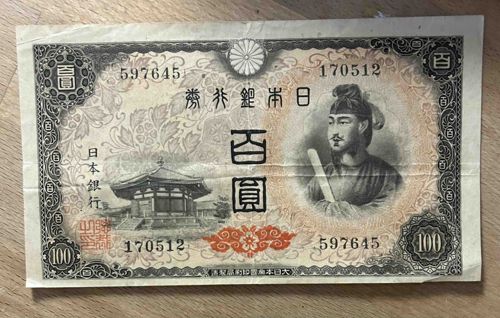
Japanese 100 Yen Banknote (Fujiwara no Kamatari Issue)
This is a historical Japanese 100 Yen banknote, likely issued sometime between 1944 and 1946 (Showa 19-21) during World War II and the immediate post-war period. The banknote features a portrait of Fujiwara no Kamatari, a prominent statesman of the Asuka period, on the right side. He is depicted wearing traditional Japanese attire, including a distinct headpiece and holding a scepter or rod. To the left of the portrait, there is an illustration of the Horyu-ji Temple's pagoda, an iconic Buddhist temple. The numerical denomination '100' appears in several places, including the bottom corners and vertically along the center-left. Japanese characters are visible throughout, indicating the bank of issue ('Nippon Ginko' - Bank of Japan) and other textual information. The serial numbers '597645' and '170512' are present in the upper and lower sections of the note, printed in black ink. The overall color scheme is muted, with grey, beige, and subtle red or orange accents, particularly in the intricate patterns and the seal towards the bottom center. The note exhibits signs of age and wear, including horizontal and vertical folds, minor creases, and slight discoloration consistent with circulation. The paper appears to be of standard banknote quality for its era, designed for durability. The borders are decorated with ornate patterns, adding to the banknote's artistic and historical appeal. A chrysanthemum seal, a national emblem of Japan, is visible at the top center. The design reflects a blend of traditional Japanese artistry and the functional requirements of currency during a significant period in Japanese history. The printing quality appears to be robust, indicating a level of craftsmanship appropriate for national currency.
AI-Generated Appraisal Disclaimer
Estimated Value
$30 - $50
Basic Information
Category
Collectible Banknote
Appraised On
November 12, 2025
Estimated Value
$30 - $50
Item Description
This is a historical Japanese 100 Yen banknote, likely issued sometime between 1944 and 1946 (Showa 19-21) during World War II and the immediate post-war period. The banknote features a portrait of Fujiwara no Kamatari, a prominent statesman of the Asuka period, on the right side. He is depicted wearing traditional Japanese attire, including a distinct headpiece and holding a scepter or rod. To the left of the portrait, there is an illustration of the Horyu-ji Temple's pagoda, an iconic Buddhist temple. The numerical denomination '100' appears in several places, including the bottom corners and vertically along the center-left. Japanese characters are visible throughout, indicating the bank of issue ('Nippon Ginko' - Bank of Japan) and other textual information. The serial numbers '597645' and '170512' are present in the upper and lower sections of the note, printed in black ink. The overall color scheme is muted, with grey, beige, and subtle red or orange accents, particularly in the intricate patterns and the seal towards the bottom center. The note exhibits signs of age and wear, including horizontal and vertical folds, minor creases, and slight discoloration consistent with circulation. The paper appears to be of standard banknote quality for its era, designed for durability. The borders are decorated with ornate patterns, adding to the banknote's artistic and historical appeal. A chrysanthemum seal, a national emblem of Japan, is visible at the top center. The design reflects a blend of traditional Japanese artistry and the functional requirements of currency during a significant period in Japanese history. The printing quality appears to be robust, indicating a level of craftsmanship appropriate for national currency.
Related Tags
Explore similar items and categories:
Get Your Items Appraised
Instant estimates of your treasures with AI-powered instant appraisals